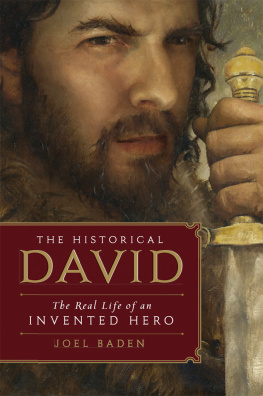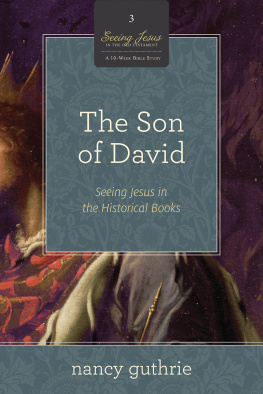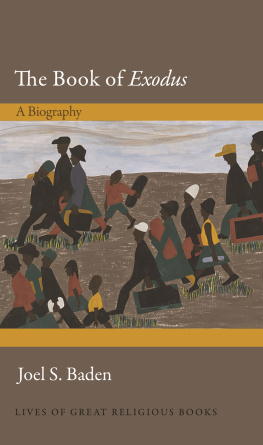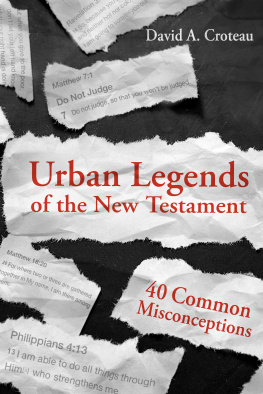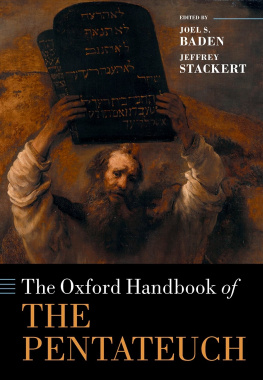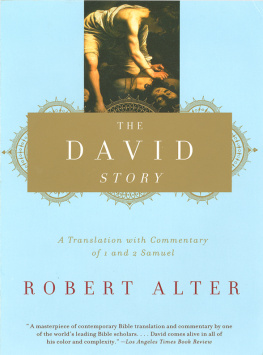For Gillian
CONTENTS
Major Sites in the David Story
I N A SMALL VILLAGE IN Israel, some three thousand years ago, there lived a man and his wife who owned flocks of sheep and goats that grazed in the fields some distance from the village. One spring day, ten men appeared in the village. They were messengers from a larger gang of fugitives from society who roamed the countryside living as they could. They presented the man with a request: they had been protecting the mans flocks and shepherds out in the fields and no harm had come to the mans property, so now they would like the man to give them some money or food for their efforts. The man, who had never encountered this gang before, much less asked them to protect his property, refused to give them anything and turned them away. The next day, the leader of the gang showed up at the mans door with his full entourage, four hundred men armed to the teeth. Shortly thereafter, the man lay dead, and the gang leader had married the mans widow, thereby assuming legal ownership of the mans flocks, servants, house, and fields.
What do we make of this sequence of events? If this were a modern court case, the circumstantial evidence against the gang leader would look bad. It would be hard not to conclude that what we have here is a classic protection racket: the initial message from the gang would be seen as a thinly veiled threat, a threat embodied in the gang leaders appearance with his armed men and fulfilled, in the end, in the mans death. The device of marrying his widow would be understood as a legal means of justifying the acquisition of the mans propertyessentially a cover-up. And the widow, taken by forceafter all, her husband lay dead before her and she was surrounded by his killerswould be as much a victim as the dead man himself.
Though it may be the most plausible explanation given the information we have, this is only one possible way of explaining the events. How we understand what happened, what meaning we make of a plain series of events, depends greatly on who is telling them, and why. As is so often the case, particularly with events from the distant past, we do not have an objective reconstruction of the story. We have no court records, no eyewitness accounts. We have only a single version of these events, and that one is counterintuitive. It presents the gang leader as the hero and the dead man as the villain. For three thousand years, it is this version that has been taken unquestioningly as the truth. For this story comes from the Bible, and the gang leader was none other than David, the future king of Israel.
W HEN I TEACH THE life of David in my Introduction to the Old Testament class, even in the setting of a prominent divinity school most of the students are unfamiliar with Davids early career as the leader of a band of misfits wandering the wilderness of Israel. Indeed, considering that David is one of the most famous characters from the Hebrew Bible, it is remarkable just how little of his life story is part of our shared cultural knowledge. This is undoubtedly in large part because most of us learn our Bible stories as children, in religious school, and most of the biblical stories about David, as we will see, are decidedly inappropriate for young ears. We know of David, but we cant say that we know him particularly deeply. The most famous image of him is Michelangelos, carved in pure white stone. Compare this with Moses, who, thanks to Cecil B. DeMilles movie The Ten Commandments (and, for a younger generation, DreamWorkss The Prince of Egypt ), is rendered in full color and motion: from his birth to the burning bush to the plagues to splitting the sea to the tablets of the Ten Commandments and the golden calf, all the way to his death.
Our knowledge of David exists not as a full-length film, but as short clips and still frames. Our first image is of him as a young man, bravely going forward to battle the Philistine giant Goliath, carrying nothing but a sling and a stone. We see Goliath towering over the Israelite army, in full armor, holding his great sword, taunting the Israelites to send someone out to fight him. We hear David recounting his tales of fighting off lions and bears to protect his familys flocks and then see him stepping out from the crowd to deliver to Goliath the immortal words: You come against me with sword and spear and javelin, but I come against you in the name of the Lord of Hosts! And we see the smooth stone striking Goliath in the forehead, the giant falling, the Philistines scattering in terror before their fallen hero.
From Goliaths death we fast-forward to David sitting on the throne of Israel, not merely as king, but as the composer of the immortal psalms. He has a lyre in his hand, the emblem of the great poet. Perhaps he is speaking those lines most familiar to us from the King James Bible: A Psalm of David: The Lord is my shepherd, I shall not want. This is David at rest, the stately ruler of a peaceful realm, offering his praises to the God who granted him victory over Israels enemies and who spared him from disaster.
These are the two moments that best represent David in the popular imagination. But there is far more to his story. The full narrative of his life takes up forty-two chapters in the Bible, spanning from 1 Samuel 16 to 1 Kings 2. The story of Goliath takes up only one chapterand the writing of the psalms is in fact nowhere in the narrative at all. There is much more to tell of David.
The details of the biblical account of Davids life, even those we are familiar with, are largely subsumed by the idea of David: an abstracted, romanticized, idealized figure, less a person of flesh and blood than a symbol of a nations glorious past and promising future. We may know Moses better, but we love David more. When I was a child, I, like every other Hebrew school student, learned a simple, one-line song, accompanied by hand gestures and repeated at increasing tempo until we could no longer keep up. David, melech yisrael, chai chai ve-kayam David, king of Israel, lives and endures. The song has no storythere is nothing to be learned about Davids life from these five words. What they represent, rather, and what was being instilled in us subconsciously, is Davids status in tradition. We were surely too young to understand, but it is noteworthy that this song describes David not as a figure of the past, but as a part of the present: he lives and endures. These words obviously cannot be used to describe a mere king from three thousand years ago. Nor, for that matter, would they be appropriate for any other character from the Hebrew Bible: we would never say that Moses lives and endures, or Abraham, or Jacob, or Isaiah. All of these figures also have legends attached to them, but David is uniquely timeless.
This timelessness is largely due to the third idea commonly associated with David, though it is one without any visual imagery: his role at the head of the lineage leading to the messiah. This idea begins already in the Hebrew Bible. At 2 Samuel 7:16 God promises David an everlasting kingship: Your house and your kingdom shall be secure before me; your throne shall be established forever. As the prophets of Israel began to look ahead to a messianic future, it was only natural that they should imagine the future redemptive king as one from Davids line. Thus Isaiah famously announces the birth of the shoot from the stump of Jesse who will rule in peace without end upon Davids throne and upon his kingdom (Isa. 11:1; 9:6). Jeremiah speaks of the time when God will raise up a righteous branch of Davids line (Jer. 23:5) and even more explicitly describes the time of Israels restoration as one when they shall serve the Lord their God and David their king, whom I will raise up for them (Jer. 30:9). Ezekiel similarly foresees the return of David in the messianic era: I will appoint over them a single shepherd to tend themmy servant David.... I the Lord will be their God, and my servant David shall be a ruler among them (Ezek. 34:2324).

